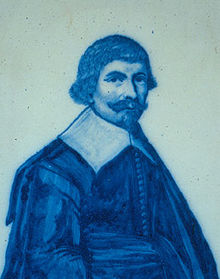Robert Junius
| Robert Junius | |
|---|---|

Portrait of Junius by Junius on Delftware
|
|
| Born | 1606 Rotterdam |
| Died |
August 28, 1655 Amsterdam |
| Residence |
Holland Dutch Formosa |
| Nationality | Dutch |
| Other names | Robertus Junius Robert de Jonghe |
| Occupation | Missionary |
| Home town | Delft, Holland |
| Title | Reverend |
Robert Junius, also recorded as Robertus Junius (born Robert de Jonghe: 1606, in Rotterdam – 22 August 1655, in Amsterdam) was a Dutch Reformed Church missionary to Taiwan (then known as Formosa) from 1629 to 1643. Along with Antonius Hambroek and Joannes Cruyf, he was among the longest-serving missionaries of the Dutch colonial era in Formosa.
On arriving in Formosa, Junius took up residence in the village of Sakam, in the vicinity of Fort Provintia in present-day Tainan City.
Described as more energetic than his contemporary, George Candidius, Junius was involved in the pacification of Taiwanese aborigines following the slaughter of sixty Dutch people by the natives of Mattau. This took the form of a short punitive war against the offending villages by Dutch forces, resulting in the killing of "a few dozen" aborigines and a Pax Hollandica which followed after the recalcitrant tribes had been cowed. Following this campaign, Junius continually urged the authorities in Batavia to send more clergymen to Formosa to assist in the instruction and conversion of the now amenable natives, something in which he was supported by the governor of the time, Hans Putmans. However, he was ultimately disappointed by the response from the colonial administrative centre.
In 1636, Junius established the first school in Formosa, teaching a class of 70 boys to write their mother tongue in roman letters.
In 1641, he was called to Batavia to report to the Consistory (the religious administrative body for Asia), and asked whether he would like to continue his service in Formosa. He agreed to return for two years, provided that
These requests were agreed upon, and Junius returned to Formosa until late 1643.
...
Wikipedia
